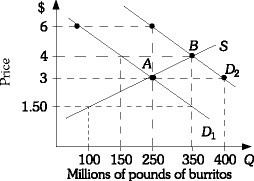A 10 percent rise in the price of housing reduces the quantity demanded of housing by 3 percent. We can conclude that the demand for housing is:
A. inelastic.
B. elastic.
C. unitary elastic.
D. perfectly elastic.
Answer: A
You might also like to view...
The typical American family spends about ____ percent of its budget on goods and the remainder on services.
A. 22 B. 32 C. 66 D. 80
If a cartel firm is producing a quantity at which the marginal revenue is $2 and the marginal cost is $2, the firm ________.
A) is producing less than the agreed upon quantity B) has erected a barrier to entry C) is producing the agreed upon quantity D) has acted in self-interest
For a firm to be economically efficient from society's point of view, it should produce to the point at which
A) marginal cost equals marginal revenue. B) marginal cost equals average total cost. C) marginal cost equals price. D) average total cost equals price.
Refer to the information provided in Figure 3.18 below to answer the question(s) that follow. Figure 3.18Refer to Figure 3.18. The market is initially in equilibrium at Point B. If demand shifts from D2 to D1, the new equilibrium price will be ________ and the new equilibrium quantity will be ________.
Figure 3.18Refer to Figure 3.18. The market is initially in equilibrium at Point B. If demand shifts from D2 to D1, the new equilibrium price will be ________ and the new equilibrium quantity will be ________.
A. $3.00; 250 B. $4.00; 350 C. $3.00; 400 D. $4.00; 150